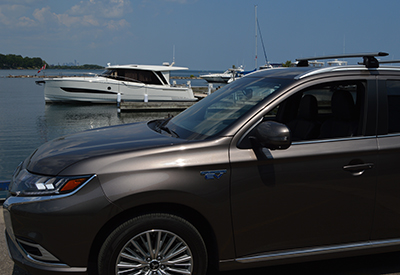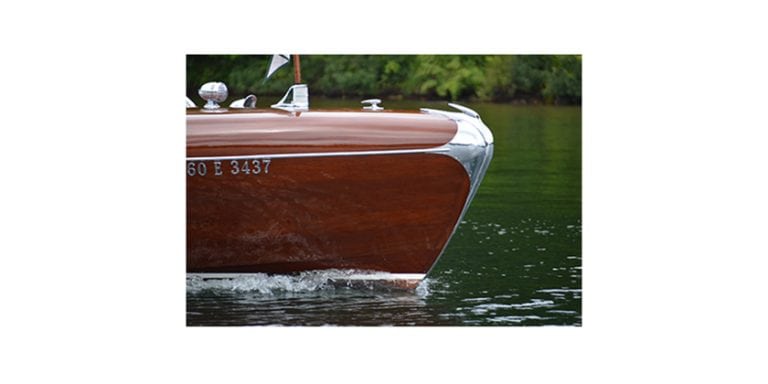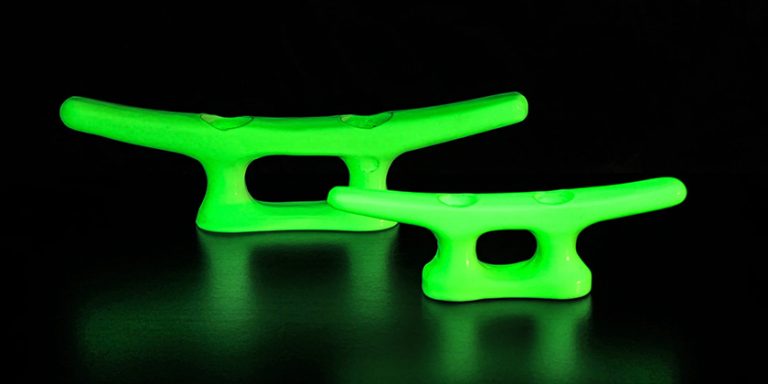Cars on Board: PHEV – what’s that?

Aug 8, 2019
When I took the Mitsubishi Outlander PHEV down to Wednesday night racing, the people that came over to inspect it out were truly surprised to see how roomy it was for an electrified vehicle. As you know, boats spawn stuff and that often requires hauling space. The (incorrect) assumption is that all hybrids and electrics are all tiny, so the Mitsubishi was already a winner on size alone.
It is a good choice for several other reasons as well. The most obvious is the eco aspect of the emerging EV driving model. Boaters, even if not tree huggers, are in touch with the planet and appreciate that tailpipe emissions are not attractive in many ways. Global warming, general pollution, depletion of resources – there’s enough reasons. So vehicles that operate on electricity that can be harvested from less offensive sources like hydroelectric dams or solar panels are clearly a net gain. If you’re electricity comes from diesel or nuclear, you may be skeptical but in Canada we are fortunate to have a fountain of clean source energy. Bottom line, I drove a week mixing city and expressway, accumulated about 250 km and my pump bill was $11.89 + a couple of bucks on my Hydro bill eventually so the hybrid does deliver some operating cost savings.
That brings us to electric vehicles of which the Mits is partially one. It is a plug in hybrid (PHEV) so it has three motors and a generator that combine in a number of operational modes. In electric mode, it is clean as noted but batteries take up space and, as noted, we need that space for boat gear. As a result of a comparatively small battery pack (compared to a Tesla, say) the Mits has limited electric range, but it turns out to be adequate for many tasks. I plugged the car into an ordinary GFI-protected outdoor socket at home overnight via the charging cable provided and was able to do about 30 km of running around in town before the gas engine kicked in. By the way, the transition between electric and fuel power is seamless, but I learned to watch the nerd screen provided so I could monitor it.
 The electric power is great for urban driving. It doesn’t idle when you start up or at intersections so no pollution or cost. The two electric motors provide barrels of torque for negotiating stop-start traffic. Then, on the highway the 2L gas engine runs since it is more efficient in. It may even take over completely, but you won’t know – such is the nature of a hybrid.
The electric power is great for urban driving. It doesn’t idle when you start up or at intersections so no pollution or cost. The two electric motors provide barrels of torque for negotiating stop-start traffic. Then, on the highway the 2L gas engine runs since it is more efficient in. It may even take over completely, but you won’t know – such is the nature of a hybrid.
Wherever you drive regenerative braking (handily controllable to provide a range of slow-down capability without hitting the friction brakes) pumps juice back into the battery. Plug in plus hybrid equals PHEV. And until our spacious country has a complete network of electric recharging stations and/or battery technology improves, this combo addresses the angst caused by range anxiety, the bugaboo of electric vehicles.
 Once we get past the tech aspects, all of which are completely invisible to the driver, we have a very nice vehicle. Seats are generous and comfortable and the back seats fold very flat to carry things. I am not the biggest fan of the mid-size traditional SUV look, but I drove a Honda Element for years so I have lost my vote on such matters. My guests thought it was classy. The inside is properly appointed and the comfort and operational ergonomics are well thought out although some additional cockpit storage for keys and sunglasses might be helpful. Fifteen hundred pound towing capacity is fine for Lasers or easily a Lightning.
Once we get past the tech aspects, all of which are completely invisible to the driver, we have a very nice vehicle. Seats are generous and comfortable and the back seats fold very flat to carry things. I am not the biggest fan of the mid-size traditional SUV look, but I drove a Honda Element for years so I have lost my vote on such matters. My guests thought it was classy. The inside is properly appointed and the comfort and operational ergonomics are well thought out although some additional cockpit storage for keys and sunglasses might be helpful. Fifteen hundred pound towing capacity is fine for Lasers or easily a Lightning.
All in all the Mitsubishi Outlander PHEV is a good functional choice for boaters who want to be planet-responsible. If you live in a province with EV rebates, the price comes down to quite reasonable. It’s Canada’s leading vehicle in its niche-but-growing category for some very good reasons.
– JM




























